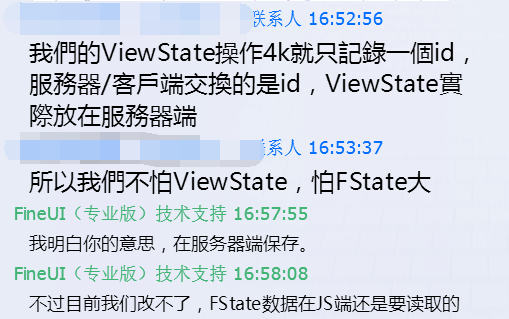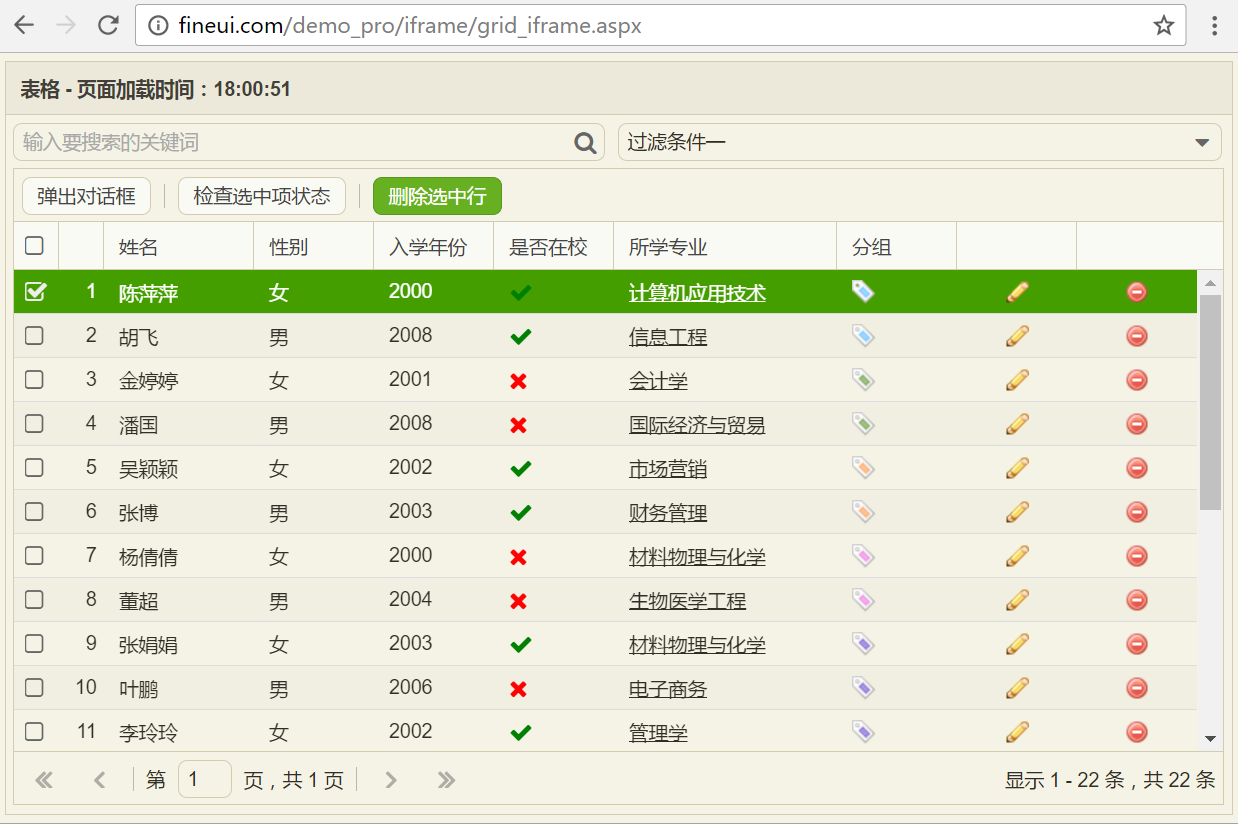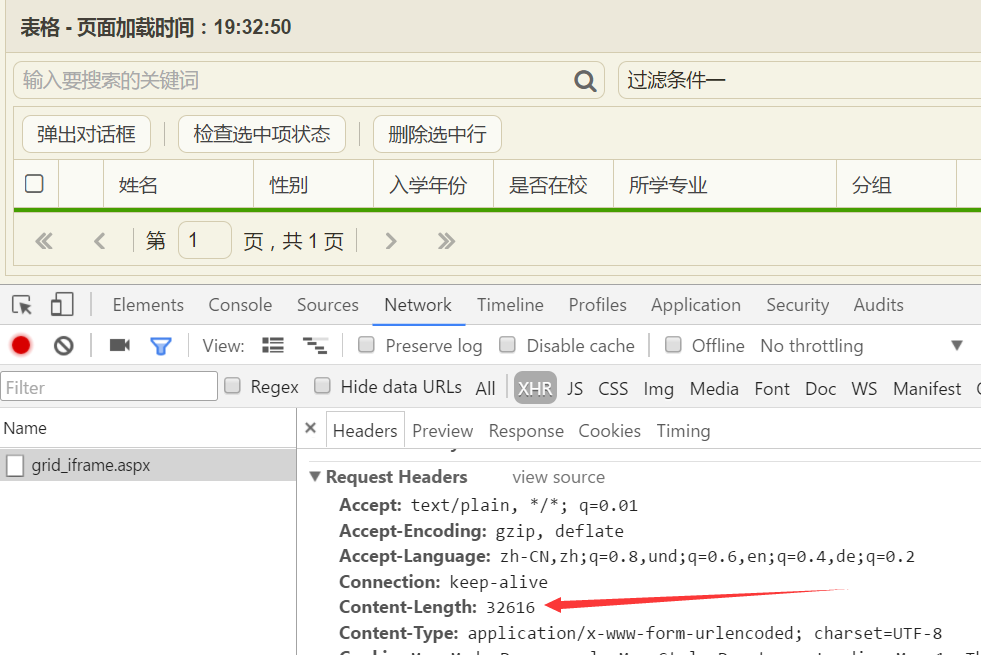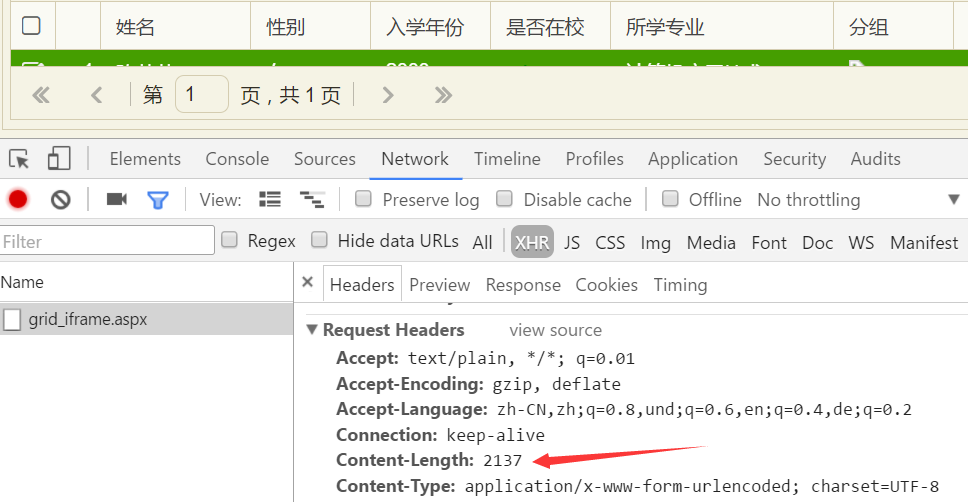FineUIPro v3.5.0发布了,减少 90% 的上行数据量,15行代码全搞定!
一切为客户着想
一切的一切还得从和一位台湾客户的沟通说起:

客户提到将ViewState保存在服务器端以减少上行数据量,从而加快页面的回发速度。
但是在FineUI中,控件状态都保存在FState中,并且为了减少下行数据量,FState的数据不仅用来保存状态,而且用于JavaScript的数据源。
所以FState必须写入HTTP响应,才能被JavaScript使用。我在之前的一篇文章中曾详细阐述:http://www.cnblogs.com/sanshi/archive/2013/01/08/2850459.html
但这的确是个问题,FState虽然能够减少下行数据量,但是页面回发时上行数据量依然很大,特别是页面中有多个下拉列表和表格时,上行的数据量可达到500K或者更多,对网速受限的环境的确是个挑战。
FineUI(专业版)v3.5.0将提供一种简单的方法,将FState保存在服务器端,从而大幅减少页面回发时的上行数据量。
注:FState仍然需要返回到页面上(以便JavaScript使用,比如作为表格和下拉列表的数据源),只不过不需要回发到服务器而已。
减少 90% 的上行数据
作为对比,我们以下面的表格页面为例:http://fineui.com/demo_pro/iframe/grid_iframe.aspx

首先选中一项,然后点击工具栏上的[删除选中行]按钮,此时会触发按钮点击事件,我们分别看下v3.3.0和v3.5.0中上传数据量。
FineUI(专业版)v3.3.0:

FineUI(专业版)v3.5.0:

FineUI(专业版)v3.3.0上行数据量:32616bytes = 31.9K
FineUI(专业版)v3.5.0上行数据量:2137bytes = 2.1K
从上面数据来看,FineUI(专业版)v3.5.0上行数据量减少了 90% 左右。在一个包含多个表格和下拉列表的页面,这个效果会更加明显。
自定义编码实现
虽然FineUI(专业版)v3.5.0提供了将FState保存到服务器端的方法,但不是默认就支持的,需要自己写点代码。因为保存到服务器有多种方法,可以保存到服务器文件中,HttpRuntime.Cache,SqlServer或者NoSQL数据库(比如Memcached,Redis)。
官网示例的PageBase.cs中提供了两种保存方式:文件、HttpRuntime.Cache,你可以直接拷贝代码到自己的项目中去。
现在来看下保存到服务器缓存中(HttpRuntime.Cache)的方法:
1. 启用PageManager的EnableFStatePersistence,并定义代理函数LoadFStateFromPersistenceMedium和SaveFStateToPersistenceMedium。
protected override void OnInit(EventArgs e) { var pm = PageManager.Instance; if (pm != null) { // FState保存到服务器缓存 pm.EnableFStatePersistence = true; pm.LoadFStateFromPersistenceMedium = LoadFStateFromPersistenceMedium_Cache; pm.SaveFStateToPersistenceMedium = SaveFStateToPersistenceMedium_Cache; } }
页面级别的支持,方便我们控制哪些页面启用,哪些页面可以不启用。
2. 获取和保存FState的代理函数
private static readonly string FSTATE_CACHE_KEY = "__FSTATE_KEY"; private JObject LoadFStateFromPersistenceMedium_Cache() { string cacheKey = Page.Request.Form[FSTATE_CACHE_KEY]; var fstate = HttpRuntime.Cache[cacheKey] as JObject; if (fstate != null) { // 缓存使用过一次后,5s后过期(用不到了) HttpRuntime.Cache.Insert(cacheKey, fstate, null, DateTime.Now.AddSeconds(5), System.Web.Caching.Cache.NoSlidingExpiration, System.Web.Caching.CacheItemPriority.Default, null); } return fstate; } private void SaveFStateToPersistenceMedium_Cache(JObject fstate) {
// 1. 生成缓存Key = 用户会话ID+当前时间 string cacheKey = String.Format("{0}_{1}", HttpContext.Current.Session.SessionID, DateTime.Now.Ticks.ToString());
// 2. 将页面的FState保存到缓存中,指定过期时间为当前用户会话过期时间(Session.Timeout) // 指定时间后过期(Session.Timeout) HttpRuntime.Cache.Insert(cacheKey, fstate, null, DateTime.Now.AddMinutes(HttpContext.Current.Session.Timeout), System.Web.Caching.Cache.NoSlidingExpiration, System.Web.Caching.CacheItemPriority.Default, null);
// 3. 将缓存Key保存到页面的一个隐藏字段中,通过PageContext.RegisterStartupScript来注册一段脚本 PageContext.RegisterStartupScript(String.Format("F.setHidden('{0}','{1}');", FSTATE_CACHE_KEY, cacheKey)); }
这里面的实现方式和在服务器端保存ViewState的方式类似。
官网示例中也有保存到服务器端文件的实现,可以参考:
private static readonly string FSTATE_FILE_KEY = "__FSTATE_KEY"; private static readonly string FSTATE_FILE_BASE_PATH = "~/App_Data/FState/"; private JObject LoadFStateFromPersistenceMedium() { string filePath = GetFStateFilePath(); string fileContent; using (StreamReader sr = new StreamReader(filePath, System.Text.Encoding.UTF8)) { fileContent = sr.ReadToEnd(); } return JObject.Parse(fileContent); } private void SaveFStateToPersistenceMedium(JObject fstate) { string filePath = GenerateFStateFilePath(); using (StreamWriter streamW = new StreamWriter(filePath, false, System.Text.Encoding.UTF8)) { streamW.Write(fstate.ToString(Formatting.None)); } } private string GenerateFStateFilePath() { DateTime now = DateTime.Now; string folderName = now.ToString("yyyyMMddHH"); string fileName = String.Format("{0}_{1}", HttpContext.Current.Session.SessionID, now.Ticks.ToString()); //Page.Request.Url.AbsolutePath.Replace(".", "_").Replace("/", "_")); string folderPath = Page.Server.MapPath(Path.Combine(FSTATE_FILE_BASE_PATH, folderName)); if (!Directory.Exists(folderPath)) { Directory.CreateDirectory(folderPath); } PageContext.RegisterStartupScript(String.Format("F.setHidden('{0}','{1}');", FSTATE_FILE_KEY, fileName)); return folderPath + "/" + fileName + ".config"; } private string GetFStateFilePath() { string fileName = Request.Form[FSTATE_FILE_KEY]; string[] fileNames = fileName.Split('_'); string folderName = new DateTime(Convert.ToInt64(fileNames[1])).ToString("yyyyMMddHH"); return Page.Server.MapPath(Path.Combine(FSTATE_FILE_BASE_PATH, folderName)) + "/" + fileName + ".config"; }
当然你也可以方便的扩展到外部数据库(SqlServer,MySql)以及NoSQL数据库(Memcached,Redis)。
使用建议
虽然EnableFStatePersistence可以极大的减少上行数据量,但并不适合于所有的场合。因为每个用户访问的每个页面都可能会产生大量的FState,所以在服务端保存意味着对服务器资源的极大消耗(内存、文件或者数据库)!
有一个简单的使用原则:
仅在上行带宽有限(也即是服务器成本低于网络传输成本)时使用,否则适得其反。
在 stackoverflow 上有一个帖子,描述了将 ViewState 保存到服务器端可能存在的问题。
启用 FineUI 的 EnableFStatePersistence 适用于同样的原则(引文中的VS指的是ViewState):
If the application recycles, the VS for all anyone using the application is lost.
It increases the memory consumption of the application. This isn't an issue if there are only a few apps hosted on a server; but there are cases when there could be many websites hosted on one box.
Scalability; the more active the application, the more VS needs to be stored. And you can't assume 1-1 (1 user - 1 VS). A user can have multiple tabs open, can go back, leave tabs inactive, etc... which leads to:
How long do you store VS? Keeping the data encoded on the page ensures that it'll still be there if the user leaves the site open for a while.
What happens if you're hosted on a web farm. We can't guarantee that the user will hit the same machine on each request.
官网示例:http://fineui.com/demo_pro/



 浙公网安备 33010602011771号
浙公网安备 33010602011771号